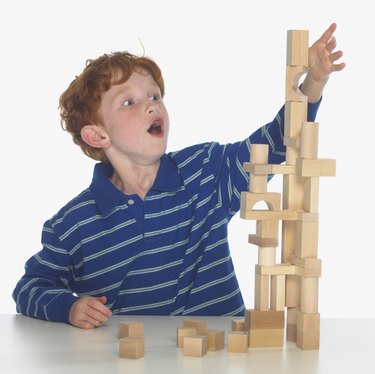
Points, lines, angles, curves, two- and three-dimensional shapes, volumes and proportions form the basics of home design as well as geometry. The living space of homes contains a wealth of three-dimensional geometry, including square and rectangular cubes, pyramids, cylinders and spheres as well as two-dimensional shapes, such as windows. Many architects, including Frank Lloyd Wright, first explored geometric ideas and building design while playing with building blocks as children.
Building Block Geometry
Video of the Day
Children frequently design houses out of blocks, creating structures ranging from simple single-story homes to elaborate multistory constructions. The dean of American architecture, Frank Lloyd Wright, said that his kindergarten experiences with wooden blocks taught him about how to combine geometric components to create buildings. Wright commented that he could still "feel" the blocks in his fingers and that "form became feeling," thus implying that the activity gave him a nearly innate understanding of the interplay of shapes and volumes. Wright became famous for his residential and commercial designs.
Video of the Day
Site Considerations
When architects design a home, one of their first geometric considerations is how to angle buildings on their sites. The direction of sunlight at various times of day and the shape of a lot affect choices, such as turning the house diagonally on the site to create a more interesting look. The slopes of the site, whether flat or angled in various parts, affect choices such as whether to build a garden-level, walk-out or below-grade basement.
Shapes and Volumes
Rooms and hallways in houses are like cubes of varying sizes and lengths that overlap, intersect, connect or stack on top of each other. The ceilings of some rooms may be low and flat whereas others, such as in attics, may slope toward outside walls lending themselves to dormers that can be thought of as smaller blocks poking out of the roof.
Uncomplicated roofs of small houses may look like triangular prisms. Larger houses may have a number of intersecting roof lines -- a collage of peaks at varying slopes and turned in different directions. Sometimes there is no peak, because the roof is a mansard that can be likened to a rectangular block with angled sides.
When all these different shapes and angles work well together, people sometimes jokingly say, "Nice pile!" as if the house were a harmonious grouping of toy blocks.
CAD and Computer Rendering
Most houses are now designed on computers. Although architects need to understand geometry, they don't manipulate formulas that computers can calculate more rapidly.
Computer-aided design (CAD) and rendering programs are based on geometric principles. They allow architects to create flat images of buildings as well as perspective drawings that provide a three-dimensional look. Designers use CAD for flat depictions of facades and floor plans. It offers ways to set proportions and manipulate a variety of geometric shapes, including lines, circles, curves, squares, rectangles, triangles and irregular polygons. It also performs geometric functions, such as rotating, sliding, flipping and repeating -- tessellating -- planes. Rendering programs, which are more complicated, create photo-realistic facades and give viewers the sense of walking around inside and outside structures.